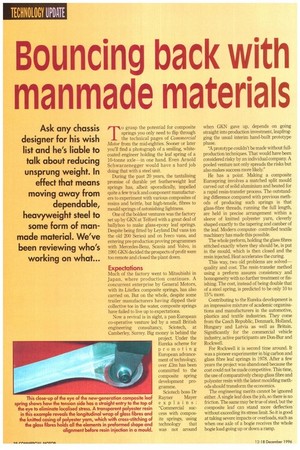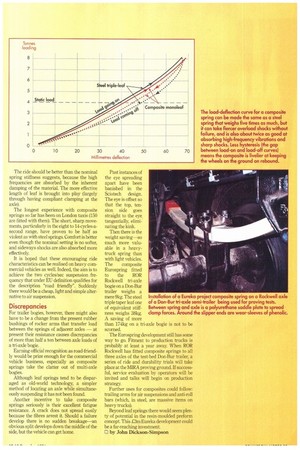Bouncing back with manmade materials
Page 44

Page 45

If you've noticed an error in this article please click here to report it so we can fix it.
Ask any chassis designer for his wish list and he's liable to talk about reducing unsprung weight. In effect that means moving away from dependable, heavyweight steel to some form of manmade material. We've been reviewing who's working on what...
To grasp the potential for composite springs you only need to flip through the technical pages of Commercial Motor from the mid-eighties Sooner or later you'll find a photograph of a smiling, whitecoated engineer holding the leaf spring of a 10-tonne axle—in one hand. Even Arnold Schwarzenegger would have a hard job doing that with a steel unit.
During the past 20 years, the tantalising promise of durable yet featherweight leaf springs has, albeit sporadically, impelled quite a few truck and component manufacturers to experiment with various composites of resins and brittle, but high-tensile, fibres to mould springs of astonishing lightness.
One of the boldest ventures was the factory set up by GICN at Telford with a great deal of ballyhoo to make glass-epoxy leaf springs. Despite being fitted by Leyland Daf vans (on the old 200 Series) and on Iveco vans, and entering pre-production proving programmes with Mercedes-Benz, Scania and Volvo, in 1991 GKN decided the prospects of profit were too remote and closed the plant down.
Expectations
Much of the factory went to Mitsubishi in Japan, where production continues. A concurrent enterprise by General Motors, with its Liteflex composite springs, has also carried on. But on the whole, despite some trailer manufacturers having dipped their collective toe in the water, composite springs have failed to live up to expectations.
Now a revival is in sight, a pan-European co-operative venture led by a small British engineering consultancy, Sciotech, at Camberley, Surrey. Big money is behind the project. Under the Eureka scheme for promoting European advancement of technology, over £3rn has been committed to the composite spring development programme.
Sciotech boss Dr Rayner Mayer explains: "Commercial success with composite springs, using technology that was not around when GI(N gave up, depends on going straight into production investment, leapfrogging the usual interim hand-built prototype phase.
"A prototype couldn't be made without fullproduction techniques That would have been considered risky by an individual company. A pooled venture not only spreads the risks but also makes success more likely."
He has a point. Making a composite Eurospring involves a matched split mould carved out of solid aluminium and heated for a rapid resin-transfer process. The outstanding difference compared with previous methods of producing such springs is that glass-fibre threads, running the full length, are held in precise arrangement within a sleeve of knitted polyester yarn, cleverly shaped exactly to the tapering and camber of the leaf. Modern computercontrolled textile machinery has made this possible.
The whole preform, holding the glass fibres stitched exactly where they should be, is put in the mould, which is then closed and the resin injected. Heat accelerates the curing.
This way, two old problems are solved— quality and cost. The resin-transfer method using a preform assures consistency and homogeneity with no further treatment or finishing. The cost, instead of being double that of a steel spring, is predicted to be only 10 to 15% more.
Contributing to the Eureka development is an impressive mixture of academic organisations and manufacturers in the automotive, plastics and textile industries. They come from the Czech Republic, Denmark, Holland, Hungary and Latvia as well as Britain. Significantly for the commercial vehicle industry active participants are Don-Bur and Rockwell.
For Rockwell it is second time around. It was a pioneer experimenter in big carbon and glass fibre leaf springs in 1978. After a few years the project was abandoned because the cost could not be made competitive. This time, the use of comparatively cheap glass fibre and polyester resin with the latest moulding methods should transform the economics.
The engineering merits cannot be ignored either. A single leaf does the job, so there is no friction. The same may be true of steel, but the composite leaf can stand more deflection • without exceeding its stress limit. So it is good at taking severe impacts or overloads, such as when one axle of a bogie receives the whole bogie load going up or down a ramp. The ride should be better than the nominal spring stiffness suggests, because the high frequencies are absorbed by the inherent damping of the material. The more effective length of leaf is brought into play (largely through having compliant clamping at the axle).
The longest experience with composite springs so far has been on London taxis (150 are fitted with them). The short, sharp movements, particularly in the eight to 14-cycles-asecond range, have proven to be half as violent as with steel springs. Comfort is better even though the nominal setting is no softer, and sideways shocks are also absorbed more effectively.
It is hoped that these encouraging ride characteristics can be realised on heavy commercial vehicles as well. Indeed, the aim is to achieve the two cycles/sec suspension frequency that under EU definition qualifies for the description "road friendly". Suddenly there would be a cheap, light and simple alternative to air suspension.
Discrepancies For trailer bogies, however, there might also have to be a change from the present rubber bushings of rocker arms that transfer load between the springs of adjacent axles — at present their resistance causes discrepancies of more than half a ton between axle loads of a tri-axle bogie. , Earning official recognition as road-friendly would be prize enough for the commercial vehicle business, especially as composite springs take the clatter out of multi-axle bogies.
Although leaf springs tend to be disparaged as old-world technology a simpler method of locating an axle while simultaneously suspending it has not been found.
Another incentive to take composite springs seriously is their excellent fatigue resistance. A crack does not spread easily because the fibres arrest it. Should a failure develop there is no sudden breakage—an obvious split develops down the middle of the side, but the vehicle can get home. Past instances of the eye spreading apart have been banished in the Sciotech design. The eye is offset so that the top, tension side goes straight to the eye tangentially, eliminating the kink.
Then there is the weight saving—so much more valuable in a heavytruck spring than with light vehicles.
The composite Eurospring fitted to the ROR Rockwell tri-axle bogie on a Don-Bur trailer weighs a mere 9kg. The steel triple taper leaf one of equivalent stiffness weighs 38kg. A saving of more than 174kg on a tri-axle bogie is not to be scorned.
The Eurospring development still has some way to go. Fitment to production trucks is probably at least a year away When ROR Rockwell has fitted composite springs to all three axles of the test-bed Don-Bur trailer, a series of ride and durability trials will take place at the MIRA proving ground. If successful, service evaluation by operators will be invited and talks will begin on production strategy.
Further uses for composites could follow: trailing arms for air suspensions and anti-roll bars (which, in steel, are massive items on heavy trucks).
Beyond leaf springs there would seem plenty of potential in the resin-moulded preform concept. This .C3m Eureka development could be a far-reaching investment.
ra by John Dickson-Simpson
















































































































